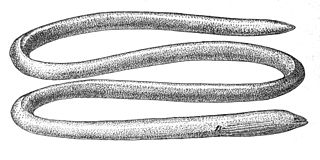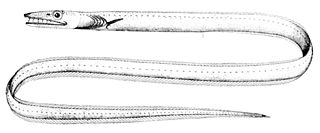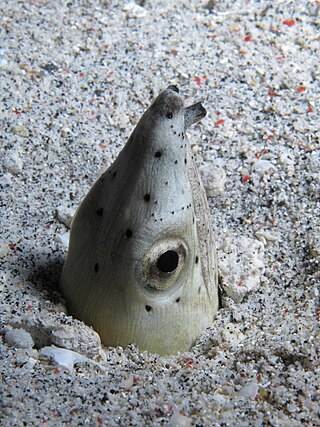
Echidna delicatula, the mottled moray, also known as the fine-speckled moray, is a moray eel. It was described by Johann Jakob Kaup in 1856, originally under the genus Poecilophis. It is a marine, tropical eel which is known from the Indo-Pacific, including Sri Lanka, Samoa, and Japan. It inhabits coral reefs. It can reach a maximum total length of 65 centimetres (26 in).
Hoplunnis is a genus of eels in the duckbill eel family Nettastomatidae. It currently contains the following species:
The Celebes longfin eel is an eel in the family Anguillidae. It was described by Johann Jakob Kaup in 1856. It is a tropical eel known from freshwaters in the Western Pacific, including Indonesia, the Philippines, New Guinea, and Western and American Samoa. The eels spend most of their lives in freshwater but migrate to the ocean to breed. Males can reach a maximum total length of 150 centimetres.
The Polynesian longfinned eel, also known as the Pacific long-finned eel, is an eel in the family Anguillidae. It was described by Johann Jakob Kaup in 1856. It is a tropical eel found in freshwaters in the Pacific, including Sulawesi, Indonesia; the Society Islands, and Pitcairn. The eels spend most of their lives in freshwater, but migrate to the ocean to breed. Males can reach a maximum total length of 100 centimetres, while females can reach a maximum TL of 165 centimetres and a maximum weight of 9,000 grams.

Moringua bicolor, the bicolor spaghetti eel, is an eel in the family Moringuidae. It was described by Johann Jakob Kaup in 1856. It is a marine eel known from Japan, Indonesia, the Philippines, and the Laccadive Sea, in the Indo-West Pacific. It dwells in temperate waters at a known depth of 3 m (9.8 ft).

The Java spaghetti eel, also known as the Java thrush-eel, Java worm eel, and the black-tailed thrush eel is an eel in the family Moringuidae. It was described by Johann Jakob Kaup in 1856, originally under the genus Aphthalmichthys. It is a tropical, marine eel which is known from the Indo-Pacific, including East Africa, the Tuamoto Islands, the Ryukyu Islands, and Micronesia. It is a burrowing species which inhabits reefs at a depth range of 2–15 m. Males can reach a maximum total length of 120 cm.
Gnathophis capensis, the Southern Atlantic conger or southern conger, is an eel in the family Congridae. It was described by Johann Jakob Kaup in 1856, originally under the genus Leptocephalus. It is a subtropical, marine eel which is known from the southeastern Atlantic Ocean, including from False Bay to Plettenberg Bay, South Africa and also on Tristan da Cunha Island. It is known to dwell at a depth of 100 metres. Males can reach a maximum total length of 37 cm.

The blacktail pike-conger is an eel in the family Nettastomatidae. It was described by George Brown Goode and Tarleton Hoffman Bean in 1896. It is a subtropical, marine eel which is known from the western Atlantic Ocean. It is known to dwell at a maximum depth of 203 meters. Males can reach a maximum total length of 36.6 centimeters.
The silver pikeconger is an eel in the family Nettastomatidae. It was described by E. David Lane and Kenneth W. Stewart in 1968. It is a marine, tropical eel which is known from the eastern Pacific Ocean. Males can reach a maximum total length of 125 centimetres (49 in), but more commonly reach a TL of 60 centimetres (24 in).
The slender duckbill eel is an eel in the family Nettastomatidae. It was described by Charles Tate Regan in 1915. It is a marine, deep water-dwelling eel which is known from the Gulf of Guinea, in the eastern Atlantic Ocean. It inhabits the continental shelf and slope. Males can reach a maximum total length of 55.5 centimetres (21.9 in).
Hoplunnis sicarius is an eel in the family Nettastomatidae. It was described by Samuel Garman in 1899, originally under the genus Atopichthys. It is a marine, tropical eel which is known from the eastern central Pacific Ocean, including Mazatlan, Mexico, and Panama. It is known to dwell at a depth of 1,431 metres (4,695 ft), and inhabits substrates. Unlike many eel species, it does not form burrows.
The spotted pike-conger, also known as the conger eel in Cuba, is an eel in the family Nettastomatidae. It was described by Isaac Ginsburg in 1951. It is a marine, deep water-dwelling eel which is known from the western Atlantic Ocean, including the Gulf of Mexico and the Straits of Florida, USA. It dwells at a depth range of 130 to 420 meters, and inhabits benthic sediments of mud. Males can reach a maximum total length of 46 centimeters (18 in).

Cirrhimuraena chinensis is an eel in the family Ophichthidae. It was described by Johann Jakob Kaup in 1856. It is a tropical, marine eel which is known from China and Papua New Guinea, in the western Pacific Ocean. Males can reach a maximum standard length of 54.8 centimetres.

The highfin snake eel (Ophichthus altipennis, also known as the blackfin snake eel or the black-finned snake eel, is an eel in the family Ophichthidae. It was described by Johann Jakob Kaup in 1856, originally under the genus Microdonophis. It is a marine, tropical eel known from the eastern Indian Ocean and northwestern and western central Pacific Ocean, including Australia, French Polynesia, Indonesia, Japan, the Marshall Islands, Malaysia, the Philippines, and Papua New Guinea. It dwells at a depth range of 0 to 40 m, and forms burrows in soft inshore sand sediments. Males can reach a maximum total length of 103 cm.

The Napoleon snake eel is an eel in the family Ophichthidae. It was described by Johann Jakob Kaup in 1856, originally under the genus Poecilocephalus. It is a marine, tropical eel which is known from the Indo-Pacific, including Durban, South Africa, Mauritius, Indonesia, Japan, Australia, and the Penghu Islands. It is known to dwell at a depth of 20 metres (66 ft), and inhabits lagoons and reefs; it forms solitary burrows in sand sediments. Males can reach a maximum total length of 75 centimetres (30 in).
Ophichthus brasiliensis is an eel in the family Ophichthidae. It was described by Johann Jakob Kaup in 1856, originally under the genus Centrurophis. It is a marine, tropical eel which is known from Brazil, in the southwestern Atlantic Ocean.

The palespotted eel is an eel in the family Ophichthidae. It was described by Johann Jakob Kaup in 1859, originally under the genus Cryptopterus. It is a marine, tropical eel which is known from the western Atlantic Ocean, including North Carolina, USA, the northeastern Gulf of Mexico, and Brazil. It dwells at a depth range of 0 to 150 meters, most often at around 5 to 40 meters. Males can reach a maximum total length of 81 centimeters (32 in), but more commonly reach a TL of 60 centimeters (24 in).

The Pacific snake eel is an eel in the family Ophichthidae. It was described by Johann Jakob Kaup in 1856, originally under the genus Muraenopsis. It is a marine, subtropical eel which is known from the eastern central and southeastern Pacific Ocean, including California, USA, Peru, the Gulf of California, Mexico, the Galapagos Islands, Colombia, Ecuador, Costa Rica, El Salvador, Honduras, Guatemala, Nicaragua, and Panama. It dwells at a maximum depth of 155 metres (509 ft), and forms burrows in mud and sand sediments. Males can reach a maximum total length of 115 centimetres (45 in), but more commonly reach a TL of 80 centimetres (31 in).
Serrivomer schmidti is an eel in the family Serrivomeridae. It was described by Marie-Louise Bauchot in 1953. It is a marine, deep water-dwelling eel which is known from the eastern and western Atlantic Ocean, including Cape Verde, Senegal, the Gulf of Guinea, and Brazil. It is known to dwell at a depth range of 0 to 2,000 metres. Males can reach a maximum total length of 65.7 centimetres (25.9 in), but more commonly reach a TL of 34 centimetres (13 in).

The Kaup's arrowtooth eel is an eel in the family Synaphobranchidae. It was described by James Yate Johnson in 1862. It is a marine, deep water-dwelling eel which is known from the Indo-Western Pacific and eastern and western Atlantic Ocean, including the Faroe Islands, Iceland, Cape Verde, the Western Sahara, Nigeria, Namibia, South Africa, Greenland, France, Saint Pierre and Miquelon, the United Kingdom, Ireland, the Philippines, Portugal, Spain, the Bahamas, Brazil, Canada, Cuba, Japan, Australia, Mauritania, Morocco, and Hawaii. It dwells at a depth range of 120 to 4,800 metres, most often between 400 and 2,200 metres, and inhabits the upper abyssal zone on the continental slope. It is intolerant of the temperatures of higher waters. Males can reach a maximum total length of 100 centimetres (39 in).









